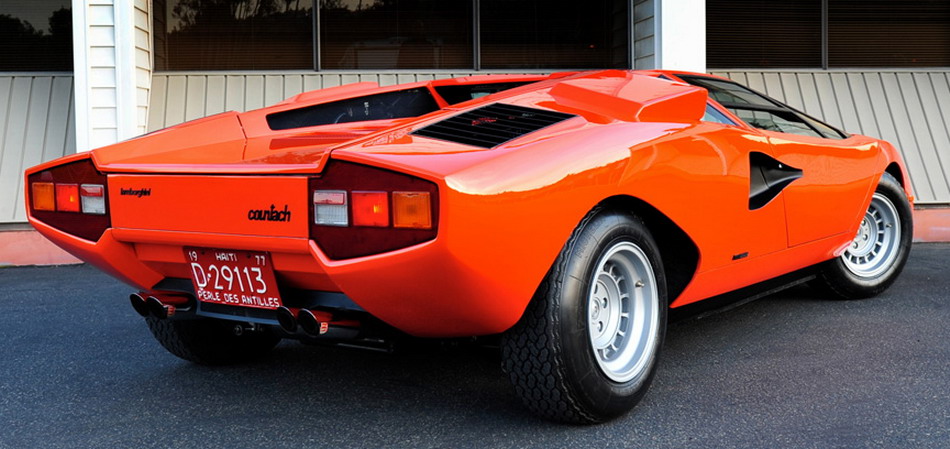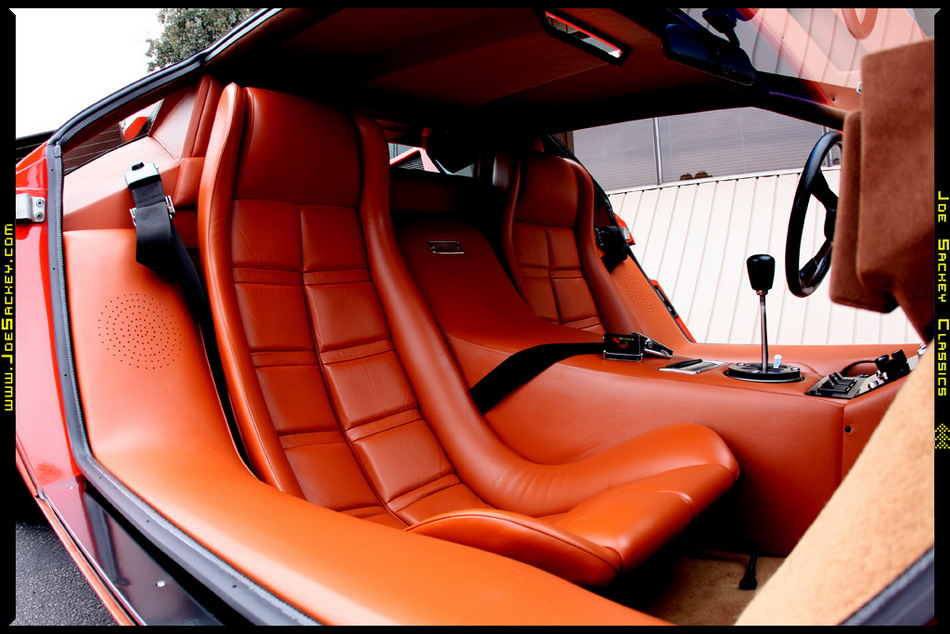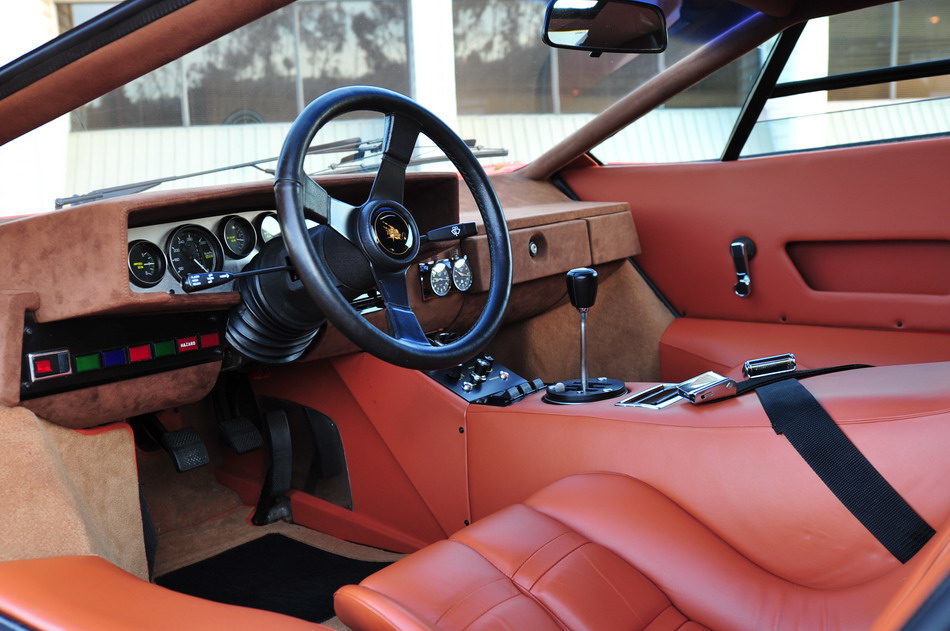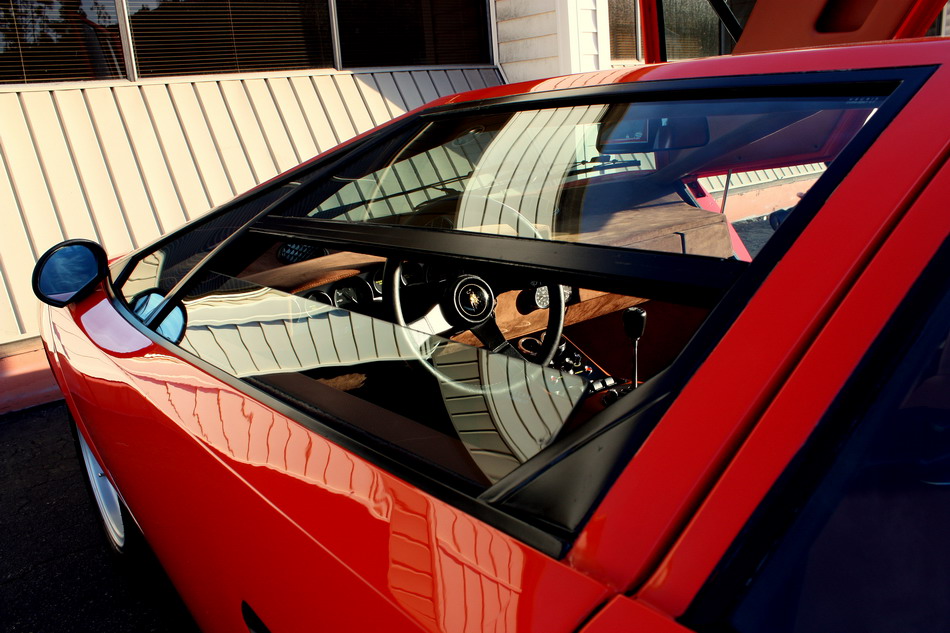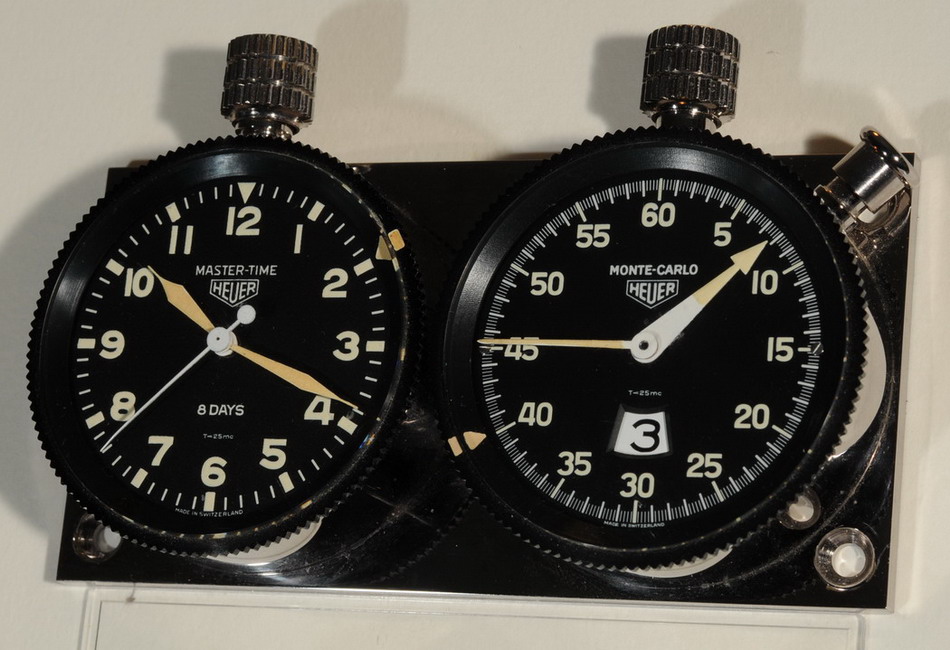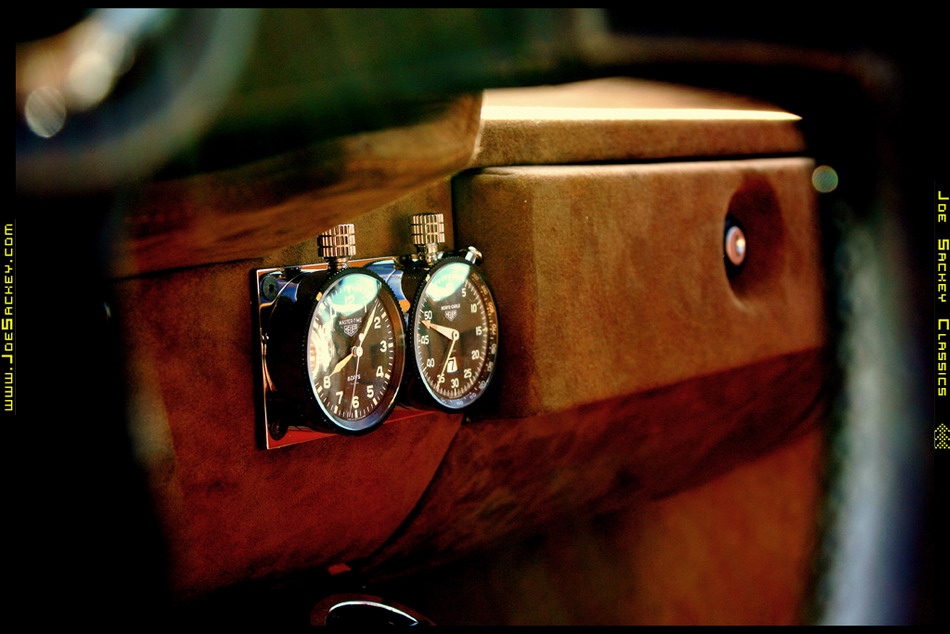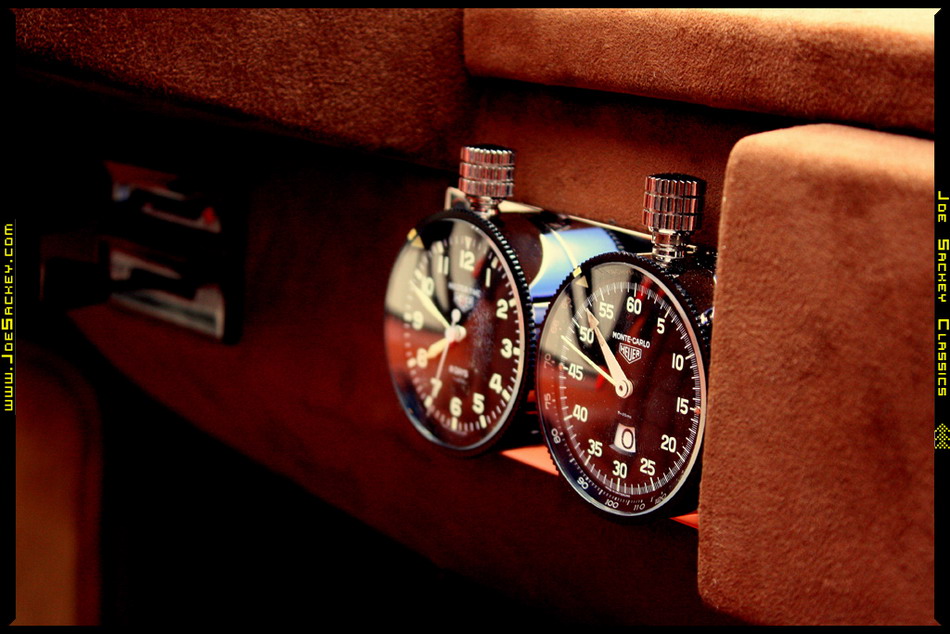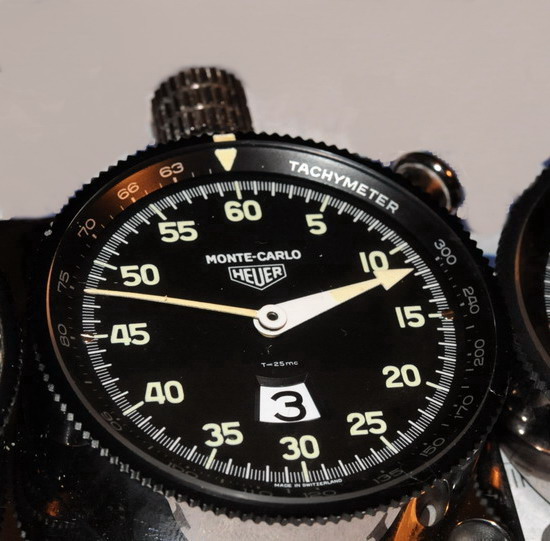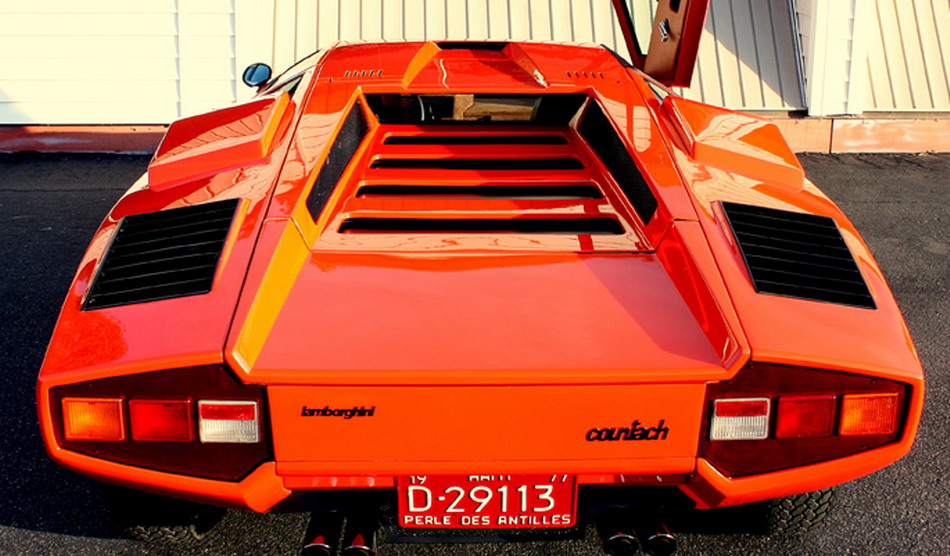Folklore has it that during a pre-delivery test run on the autostrada in January 1975, this 1974 Lamborghini Countach LP400 ‘Periscopa Speciale’ (chassis number 1120056) achieved a speed of 202 miles per hour (326 kph), making it the first production road car to break the 200 MPH mark. While today’s consensus dismisses the 200 MPH claim, this Countach can stake a legitimate claim of being the fastest road car in the world, at that time.
The car had been specially ordered by Albert Silvera, a wealthy car collector living in Haiti who was a VIP customer of both Lamborghini and Ferrari. One of the items that Silvera specified for his Countach was a pair of Heuer Rally Master dash-mounted timepieces, consisting of a matching 8-day Master Time clock and a 12-hour Monte Carlo stopwatch.
This is a brief overview of the Silvera Countach, with a focus on the Heuer timepieces that were factory-installed, upon Mr/ Silvera’s request.
The Basics. The LP400 was the first production model of the Lamborghini Countach, and was first sold in April 1974. Powered by a 4.0 liter 12-cylinder engine, the LP400 is sometimes called the “narrow body” Countach, as later models added scoops, scallops and spoilers.
Albert Silvera’s Countach — with chassis number 1120056 and engine number 1120056 — was the 28th Countach produced, being built in November and December 1974, and completed on January 23, 1975. A total of approximately 158 LP400s were built over the period from 1974 through 1977, making Silvera’s one of the earlier models in the series.
Albert Silvera. To understand this particular car, it is important to understand the man who ordered the car. Albert Silvera is usually described as a wealthy hotelier, diplomat and sports car fanatic, with the words “playboy” and “jet-setter” usually found somewhere in the description. Silvera owned the exotic El Rancho Hotel near Port Au Prince in Haiti, a celebrity destination during the 1960s and 1970s to the likes of Liz Taylor & Richard Burton, as well as Mick Jagger. Silvera special-ordered most of his Italian cars directly from Enzo Ferrari or Ferruccio Lamborghini, with each of these cars built to one-off specification and including a variety of special appointments.
Silvera was the Director of Tourism of Haiti and, with his status as a diplomat, he was able to bring his cars into the United States, without being required to modify them to meet increasingly stringent federal emissions and safety standards. Records show that Silvera had his Countach in Haiti, South Florida and Paris, as he had homes in each of these locations.
Scroll down to the bottom of this posting for additional information about Albert Silvera.
Special Finishes. Silvera selected a special exterior paint for his Countach, referenced in factory papers as “Rosso Speciale”. The special worksheet for the car notes that the interior color was originally to be “nero” (black), but this is crossed out and “Tab” (short for “Tobacco”) is entered, to accommodate Silvera’s wishes for a special leather interior. The carpeting and the dashboard materials were supplied to Lamborghini by Ferrari SpA, as Silvera was also a VIP customer of the Ferrari factory and was able to request that these materials be provided to the rival Lamborghini factory.
And a Very Special Engine. Silvera’s special Countach was sent to Dallara Automobili SrL, where the engine was blueprinted, balanced and tuned by means of high-lift camshafts, bigger intakes, bigger main jets for the carburetors, free flow headers and an open exhaust system. These modifications increased the standard 375 bhp LP400 engine’s output by 60-70 bhp. Dallara was world-renowned as a chassis, development and performance engineer. Dallara first made his mark with the launch of Lamborghini’s benchmark Miura, and he went on to be responsible for the world-championship winning Lancia Stratos. Back in 1975, Dallara was the man that Lamborghini retained to produce a factory “hot rod” whenever VIP clients such as Albert Silvera and Walter Wolf wanted performance upgrades.
The Price of Being Special. With all the custom work and finishes specified by Silvera, the price of his Countach jumped from the standard price of $43,000 to a final price of $60,000. Ironically, Silvera owned the car for only 14 months, at which time he sold 1120056 to make room for his next specially-ordered Countach.
What’s That OnTheDash? Looking through the driver’s window, we see that there is a pair of Heuer timepieces mounted on the dashboard. While we are accustomed to seeing Heuers mounted on the dashboards of rally and race cars, it is very unusual to see them on the dashboard of a road car.
The Heuer Rally Master pair consists of a Master Time 8-day clock (on the left) and a Monte Carlo 12-hour stopwatch (on the right), both attached to a dedicated back-plate (also made by Heuer).
The Master Time is a simple time-of-day clock with a rotating bezel that can be used to mark a specific time. The Monte Carlo displays hours by Arabic numerals seen through a “window” at six o’clock, minutes by a wider hand with an arrow on the end, and seconds by a narrower hand. The hour disc and both hands return to zero, when the button at two o’clock is pressed. Each timepiece is attached to the back-plate by three small screws; the back-plate is attached to the dashboard by four larger bolts, one at each corner of the back-plate.
A Special Rally Master Pair. Silvera’s Countach included many special elements, so it is fitting that the Rally Master pair that he chose for the car also includes a special feature. While most Monte Carlos have a plain rotating bezel, with a triangle to mark a specific time, the Monte Carlo included in Silvera’s Countach has a rotating Tachymeter bezel. This bezel shows speed over a measured distance (for example, a car covering one mile in 27 seconds has traveled at 133 miles per hour over the mile; a car covering one mile is 18 seconds has averaged 200 MPH for that mile).
While we can question the usefulness of any rotating bezel for actually computing speeds, the Tachymeter bezel was a symbol of the motorsports-watch connection in the 1960s and 70s, with Tachymeter bezels being features of many popular chronographs — the Heuer Autavia, Rolex Daytona and Omega Speedmaster, among others.
The Perfect Way to Trim Out the World’s Fastest Road Car. Albert Silvera was a fascinating man, who ordered up what would be among the world’s fastest road cars. His Countach is one of the most celebrated Lamborghinis in the history of the marque. The Heuer Rally Master pair was the perfect finishing touch on this supercar.
Other Interesting Installations. We are always looking for interesting installations of Heuer dashboard timers on vintage road, racing or rally cars, as well as boats and airplanes. If you know of an interesting car, boat or plane with Heuers OnTheDash, please write to me at OnTheDash@bellsouth.net.

Thanks; Additional Resources
Special thanks to Joe Sackey, for answering a couple of my questions about the car and for allowing me to use his article about the car and his photos.
You can view additional photos of the ex-Silvera Countach here.
Joe Sackey’s Description of Lamborghini Countach LP400 ex-Silvera (Chassis 11200056)
The following is from the website of Joe Sackey Classics, LLC, copyright 2012; used with permission.
1974 Lamborghini Countach LP400 ‘Periscopa Speciale’, chassis number 1120056, engine number 1120056, built November & December 1974, completed January the 23rd 1975. Delivered to Albert Silvera*, Lamborghini VIP client and world-renowned collector of sportscars, on January the 27th 1975.
*Silvera is best described as a wealthy hotelier, diplomat, sports car fanatic and old-time playboy (and not necessarily in that order!). He owned the exotic El Rancho Hotel near Port Au Prince in Haiti, jet-set destination during the 1960s and 1970s to the likes of Liz Taylor & Richard Burton, Mick Jagger & Jerry Hall etc. He was also Haiti’s Director of Tourism. He special-ordered most of his Italian cars directly from Enzo Ferrari or Ferruccio Lamborghini, all built to one-off specification with special appointments. His diplomatic status allowed him to import his one-off Ferrari and Lamborghini Supercars into the USA in the 1970s without modifying them, running
them as he did on Haiti diplomatic plates. In the 1970s, Ferrari specialists Cresswell-Baumgarten in Fort Lauderdale were responsible for the maintenance of the entire Silvera car collection at both his Miami mansion and his Port Au Prince hotel.
Rosso Dino (orange) paint, special Tabacco (brown) leather, ‘Motore Potenziato’ (tuned engine) carried out for Automobili Ferruccio Lamborghini SpA by Dallara Automobili SrL (Giampaolo Dallara**). The completed car was sent to Dallara Automobili SrL where the engine was blueprinted, balanced, and tuned by means of high-lift camshafts, bigger intakes, bigger main jets for the carburetors, free flow headers, and an open exhaust system. All this increased the standard 375 bhp LP400 engine’s output by 60-70 bhp, an 18- 20% power increase.
**Dallara is world-renowned as a chassis, development and performance engineer of unparalleled accomplishment. He first made his mark with the launch of Lamborghini’s
benchmark Miura, then went on to be responsible for the world-championship winning Lancia Stratos. His racing chassis have won half-a-dozen Indy 500, and his cars are dominant at every level from Formula 1 to Le Mans. Abarth, Audi, Chrysler, De Tomaso, Fiat, Ferrari, Lamborghini, Lancia, Nissan and Toyota have all benefited immensely from the chassis genius’ work. However, back in 1975, the engineering icon was the man that Automobili Ferruccio Lamborghini SpA automatically retained to produce a factory “hot rod” whenever VIP clients such as Albert Silvera and Walter Wolf demanded one.
Heuer Monte Carlo rally clocks fitted.
The Certificato di Garanzia (warranty certificate) dated January the 27th 1975 notes the car’s color as “Rosso Speciale” instead of the Rosso Dino noted on the worksheet, and is signed by Albert M. Silvera, Port Au Prince, Haiti.
The Lavori Speciali (special worksheet) notes that 1120056 is the 28th Countach. Colore interno (interior color) is originally noted as nero, but this is crossed out and “Tab” (short for Tabacco) is entered, obviously to accommodate Silvera’s wishes for a special leather interior. The carpeting and the dashboard material was supplied by Ferrari SpA with whom Silvera had a close working relationship and where he was considered a VIP customer.
The aforementioned special work increased the car’s base $43,000 price to $60,000, an increase of $17,000 or 28%.
The car’s file notes that on February the 3rd 1975, it was shipped to Paris, to Silvera’s home, in care of a Signor Gallerani.
August 1975 – Flown via Miami, Florida, to the El Rancho Hotel, Port Au Prince, Haiti, Silvera’s home.
On November the 18th 1975, two free maintenance coupons were returned to Sant Agata for the 1,000 and 5,000 km services carried out in Paris by Garage Thepenier SA.
Exclusively featured cover car of a major Countach article in the December 1975 issue of Car & Driver magazine. As noted in the article, 1120056’s special build includes 2 noteworthy features:
1. A factory-installed “small brass plaque inside that guarantees the car was built especially for him” (Silvera).
2. An engine tuned by Giampaolo Dallara to “60-70 bhp over production”, bringing the base Countach price cost of $43,000 to $60,000.
The magazine also notes a “pre-delivery test run on the autostrada where some brave pilot stopped the clocks at 326 kilometers per hour (202 mph)”. The writer of the piece, noted journalist Don Sherman states that this information is supplied by the Lamborghini factory. This publication suggests that 1120056 is the first-ever production road car to break the 200 mph barrier, and was clearly the fastest production road car in 1975.
Featured in the book ‘Lamborghini Countach & Urraco 1974 – 1980’ by Brooklands books.
April 5th 1976 – Albert Silvera sells 1120056 to make way for his next special-order Countach, chassis number 1120222. The sale is witnessed at the Embassy of the United States of America in Port Au Prince, Haiti. The new owner of 1120056 is Gary Doll, of Cape Coral Florida.
In September 1978, Doll writes to Lamborghini requesting requesting build information on 1120056.
On October 3rd 1978, Automobili Ferruccio Lamborghini SpA writes back to Gary Doll acknowledging his ownership of 1120056. The hand-typed letter signed by Remo Vecchi states amongst other things that: “This car was actually built for our good customer Mr Albert Silvera…” It goes on to state: “Versus the regular Countach, this car has had an engine trimmed to give more HP’s…” confirming its status as a genuine factory performance special. Finally, the letter also confirms “For the interior, we had used a special leather of high quality”. The letter is stamped as having been received by Doll on October 10th 1978.
1980s – Sold to a New York based enthusiast.
2000 – Sold to California.
April 4th 2001 – Third Party EPA & DOT releases granted, officially making 1120056 USA legal.
Featured in a major Countach article in Octane magazine.
Featured in a major Countach article in Sports Car International magazine.
2003 – Engine rebuilt by ex-Lamborghini factory development engineer Claudio Zampolli at 31,000 km (19,262 miles).
2008 – Shown at Quail Lodge motor-sports event.
Featured in the book ’50 years with Car & Driver’ by Filipacchi Publishing.
November 2009 – Ing Giampaolo Dallara contacted and he confirms tuning Silvera’s 1975 Countach. In correspondence dated November 24th 2009, Dallara states: “We improved the power with different camshafts, bigger diameter intakes, different carburetor settings, and bigger diameter exhaust (headers). The engine was a little noisier and more ‘peaky’, but more powerful”.
1120056 remains the only pure design ‘slim-body’ LP400 which received Ing Dallara’s special engine tuning (the others were the later ‘S-bodied’ LP400 of Silvera, Wolf et al, modified with spats, spoilers, wide wheels & wings).
December 2009 – Serviced by Ing Claudio Zampolli at 33, 219 km (20,641 miles).
ALBERT SILVERA, THE MAN
Who was the late Albert Silvera?
Timothy Benford: “Albert Silvera was one of the wealthiest, and most influential people in Haiti. Easily a millionaire by any standards. He had a penchant for beautiful and expensive cars…. You have to understand who Albert Silvera was and that he was someone who was used to getting his own way. He had been Haiti’s Ambassador-at-large for as long as anyone could remember. No matter who was in power in Haiti since the 1940s, Silvera used his wealth to charm his way into their circle… During the German occupation of Paris in World War II, Silvera spent almost a year in the City of Lights on a “diplomatic” mission and had a Wehrmacht chauffeur and a Mercedes at his constant disposal…. he had been a “spy-agent” working with Wild Bill Donovan and the OSS (predecessor to the CIA)”
Larry Edsall: “Albert Silvera a Haitian diplomat and well-known car collector not only wanted a new Ferrari 275 GTB, but he wanted to receive his car personally from Il Commendatore…. Silvera, the owner of the acclaimed El Rancho Hotel in Port Au Prince, ordered his 1965 Ferrari 275 GTB through Luigi Chinetti Motors of Greenwich Connecticut. But, this was no ordinary 275 GTB…. Silvera not only wanted the long-nose car with the optional six-Weber carburetor intake-manifold setup, but he specified his to be painted electric blue (‘Blu Silvera’), and that it have a Rosso leather interior!… Silvera had Scaglietti add headrests and armrests, removable seat cushions, and a removable dash cover, snap exhaust setup, Borrani wire wheels, brightwork on the fender and sail panel vents, velocity trumpets, and a special rear bumper indented to display the (diplomatic) license plate…. Silvera won his audience with Enzo. When he went to pick up his car, he was wise to take along several young women. Ferrari’s sales manager immediately brought Il Commendatore out for personal introductions all round”
Claudio Zampolli: “Whilst I was working at the Lamborghini factory, whenever Albert Silvera arrived, he was in the company of a woman so breathtaking in beauty that the entire plant stopped work just to stare…. Ferruccio Lamborghini would have the main gate call him to announce Silvera’s arrival. As the client walked in to the delivery area to collect his new special order Lamborghini, Commendatore would already be there, polishing away at it. I guess Silvera was good for business!”
Tim Stanford: “I worked with Al Roberts at Cressman-Baumgarten and we were responsible for looking after Silvera’s car collection. I remember the orange LP400 very well, one of the first Countachs in the USA. All of Silvera’s cars were one-off specials from Ferrari or Lamborghini. Ferrari named the special colors after him, such as Silvera Blue etc. I remember he always reminded us he had diplomatic immunity so speeding tickets were not a problem. None of the cars needed to be modified to conform to USA regulations and they were all maintained in European specification just as they were built. I remember the special plaque in the LP400 noting its build just for him and the Heuer rally clocks”.
Al Roberts: “At my time with Cressman-Baumgarten I remember the ‘orange Lamborghini’ very well. It was brand new, and we kept it that way. We looked after Silvera’s Miami car collection, but he also flew us to Haiti to service the cars there such as the Miura SV Jota etc. The ‘orange Countach’ stayed in Miami though, and he used it when he was in Florida. The interior was brown, a leather trim color he really liked as a couple of the Ferraris including a 275 GTB I remember were special trimmed that way. I remember the orange Countach was tuned by Dallara for the Lamborgihini factory and it was very fast. Silvera was an accomplished driver though, but not hard or abusive. Our job was to make sure everything operated absolutely perfectly. He was an old-time playboy who dressed in sharp white linen suits”
Elisabeth Silvera Ducasse: “My mother Gladys was involved in specifying the colors of my father’s unique cars, and she even sketched some of the bodywork changes he wanted so they could be carried out”


